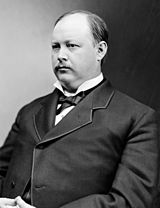U.S. House election, 1888
|
|
|||||||||||||||||||||||||||||||||||||||||||||||
|---|---|---|---|---|---|---|---|---|---|---|---|---|---|---|---|---|---|---|---|---|---|---|---|---|---|---|---|---|---|---|---|---|---|---|---|---|---|---|---|---|---|---|---|---|---|---|---|
|
|||||||||||||||||||||||||||||||||||||||||||||||
|
All 332 seats to the United States House of Representatives 167 seats needed for a majority |
|||||||||||||||||||||||||||||||||||||||||||||||
|
|||||||||||||||||||||||||||||||||||||||||||||||
|
|||||||||||||||||||||||||||||||||||||||||||||||
Thomas Reed
Republican Party (United States)
Elections to the United States House of Representatives held in 1888 were held to choose members of the 51st Congress, and were held at the same time as the election of President Benjamin Harrison.
Harrison's Republican Party gained a majority in the House at the expense of the Democratic Party, even though incumbent President Grover Cleveland actually received more votes than Harrison. The issue of tariffs played a key role in this election. The Democrats, with the support of farmers and laborers, wanted to lower tariffs in order to promote free trade, while the Republicans, backed by industry and big business, believed that higher tariffs were necessary to protect American manufacturing. Especially in industrializing regions, voters chose the Republican view on tariffs, as they gave the party a slim majority in the House.
Seven seats were added, for the six new states of, in order of admission (number of House seats for each new state listed in parentheses): North Dakota (1), South Dakota (2), Montana (1), Washington (1), Idaho (1), and Wyoming (1).
The previous election had 4 third-party candidates, 2 Labor, 1 Greenback, and 1 Independent.
...
Wikipedia



